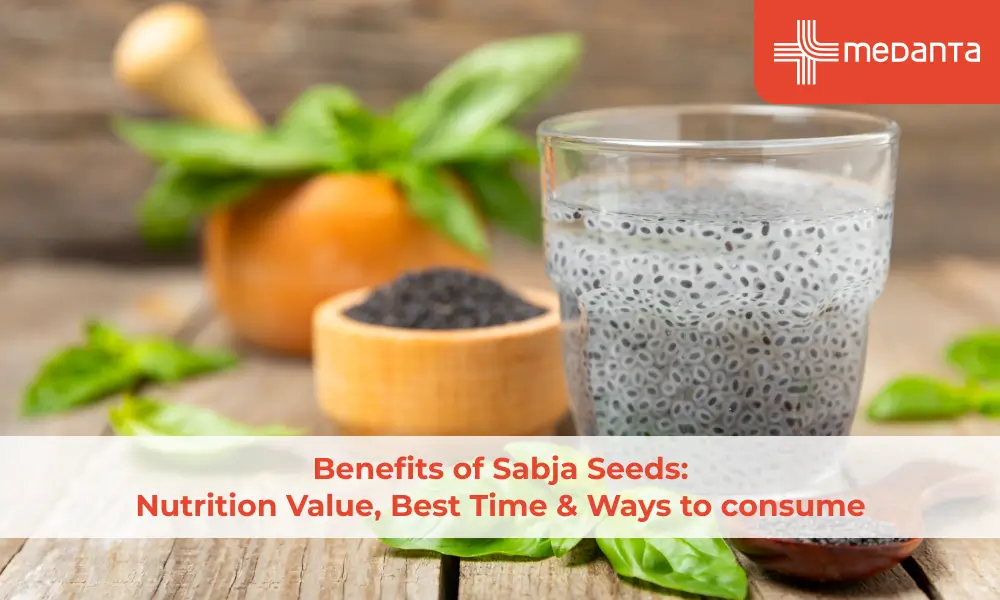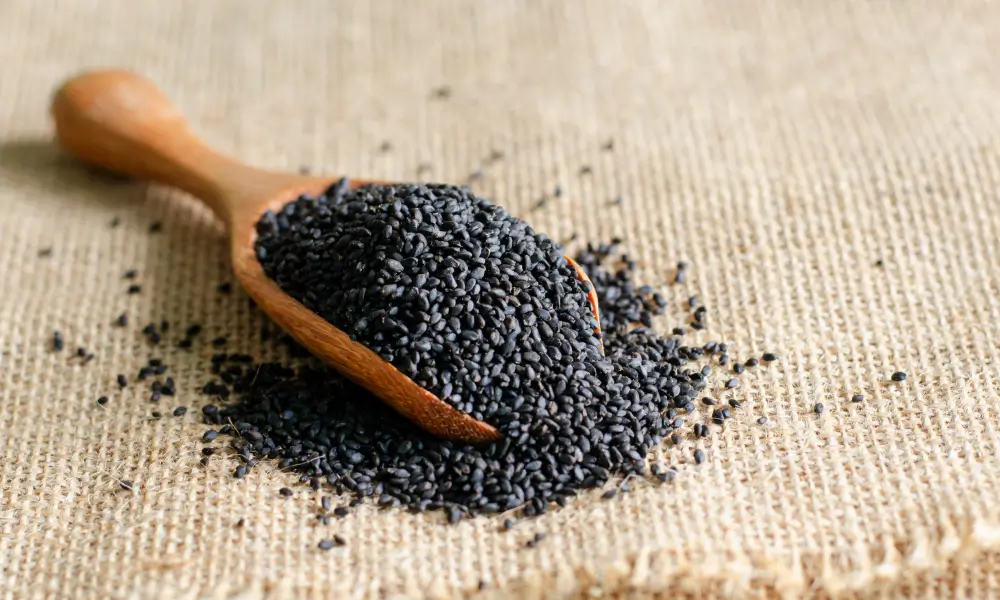Benefits of Sabja Seeds: Nutrition Value, Best Time & Ways to consume

TABLE OF CONTENTS
Sabja seeds are small, yet they pack a punch when it comes to their benefits. These incredible seeds contain enough nutrients to be called a superfood. They consist of 43.9% carbohydrates and plenty of dietary fibre. The seeds also contain 33% lipids, with alpha-linolenic acid making up the majority. This essential omega-3 fatty acid helps maintain heart health.
These small black seeds are loaded with plant compounds like flavonoids and polyphenols. Two teaspoons of sabja seeds soaked in water provide just 40 calories. The high soluble fibre content helps people stay full longer, which makes them popular among health enthusiasts. Their balanced nutritional profile and adaptability make them perfect for foods and drinks of all types.
The nutritional makeup of sabja seeds shows why these tiny powerhouses deserve a place in your diet. Every 100g of seeds contains about:
Protein - 14.8g
Lipids - 13.8g
Carbohydrates - 63.8g
Fibre - 22.6g
These seeds also have essential minerals like:
Iron - 2.27mg
Magnesium - 31.55mg
Zinc - 1.58mg
Top Health Benefits of Sabja Seeds
Sabja seeds pack remarkable health advantages beyond their simple nutrition:
Aids digestion: Their high fibre content regulates bowel movements and prevents constipation
Controls blood sugar: They slow carbohydrate absorption, preventing sugar spikes
Supports heart health: Rich in omega-3 fatty acids that reduce inflammation and improve cholesterol levels
Cooling effect: Acts as a natural body coolant during hot weather
Improves skin health: Contains antioxidants that fight free radicals causing skin damage

What Is the Safe Daily Amount of Sabja Seeds?
Most adults can consume 1-2 tablespoons (about 15-30g) of sabja seeds each day without worrying about their health. Start with smaller amounts if you are new to them, as their high fibre content might cause bloating at first.
Ways to Use Sabja Seeds in Drinks and Foods
Drinks | Foods | Preparation Method |
Lemonade | Desserts (puddings, ice cream) | Soak 1 tbsp in warm water for 15-20 minutes before use |
Smoothies | Yoghurt | Add soaked seeds to smoothies or yoghurt for a thicker texture. |
Milkshakes | Salads | Mix soaked seeds into your milkshakes and fruit salads for texture |
Coconut water | Falooda | Stir soaked sabja seeds into these drinks for added freshness |
Buttermilk | Baked goods | Can replace eggs in baking (1 tbsp seeds in 3 tbsp water) and enhance the taste of your plain buttermilk |
Best Time to Consume Sabja Seeds for Maximum Benefits
Your metabolism gets a boost when you take these seeds on an empty stomach in the morning. Taking them before meals helps reduce appetite and manage weight better. People with digestive issues find relief when they consume sabja seeds after dinner to help with overnight digestion.
Sabja Seeds Side Effects for Females and Precautions
Sabja seeds provide amazing benefits but can cause side effects under specific conditions. These seeds may affect hormone levels, so women with hormone-sensitive conditions need to be careful. A few people might get allergic reactions that show up as itching, rash or swelling.
Women should keep an eye on how many seeds they eat as eating too many seeds can disturb their hormonal balance and menstrual cycles. The seeds might lower oestrogen levels, which means expecting mothers need to be extra careful. However research hasn't proven these effects on pregnancy.
The following are some common side effects:
Bloating and gas from the high fibre content
Risk of dehydration since seeds absorb lots of water
You should check with your doctor before eating sabja seeds if you take:
Blood thinners because the seeds slow blood clotting
Diabetes medications as they can change blood sugar levels
Any medicine that changes your blood pressure
The best way to enjoy sabja seeds safely is to soak them properly. Stick to 1-2 tablespoons daily and add them to your diet slowly. If you are planning surgery, stop eating these seeds at least two weeks before the procedure. These seeds offer many health benefits, but moderate consumption helps you get the most value while avoiding side effects.
Conclusion
Sabja seeds are small but powerful nutritional gems. These black seeds deliver amazing health benefits that range from better digestion to balanced blood sugar levels. You can add them to drinks and foods, which makes them perfect for daily meals.
New users should start with a teaspoon of sabja seeds. The amount can be increased to 1-2 tablespoons daily. A balanced approach works best when adding superfoods to your diet. Clever use of sabja seeds has a positive impact on your health and well-being.
FAQs
What are the main health benefits of sabja seeds?
These small black seeds have many positive effects on your body. These include:
They naturally cool your body, which makes them perfect for summer.
The high fibre content helps with digestive problems like constipation, bloating, and acidity.
These seeds help control blood sugar levels, boost immunity with antioxidants, and promote heart health through omega-3 fatty acids.
They also help with respiratory conditions like asthma because of their anti-inflammatory properties.
How much sabja seeds should I eat daily?
You should aim for 1-2 tablespoons (about 15-30 grams) each day. New users should start with just one teaspoon.
Are there any side effects of sabja seeds for females?
Yes, eating too many seeds can affect women's hormone levels and cause irregular periods. Women who have hormone-sensitive conditions should check with their doctor before regular use. Pregnant women need medical advice since these seeds can impact oestrogen levels.
What is the nutritional content of sabja seeds?
Per 100g, sabja seeds contain:
14.8g protein
13.8g lipids
63.8g carbohydrates (22.6g fibre)
2.27mg iron
31.55mg magnesium
Can sabja seeds help in weight loss?
They sure can! The high fibre makes you feel full and reduces snacking. The seeds expand in water and help control hunger. The alpha-linolenic acid in these seeds also speeds up your metabolism.
Is it safe to eat sabja seeds during pregnancy?
Doctors usually allow very small amounts during pregnancy. The seeds might cause uterine contractions early in pregnancy. They can also affect oestrogen levels, which play a vital role in foetal development. Make sure to talk to your doctor before adding them to your pregnancy diet.
How are sabja seeds different from chia seeds?
Sabja seeds are smaller, black, and shaped like teardrops, while chia seeds are bigger with black and white spots. Sabja seeds swell up faster (within 15 minutes) than chia seeds (30 minutes to 2 hours). Chia seeds have more omega-3 and protein, making them better for weight loss. Sabja seeds work better as body coolants.
When is the best time to consume sabja seeds?
The best time to eat sabja seeds is early morning on an empty stomach or 30 minutes before meals. This timing helps the body absorb nutrients better and has an influence on appetite control.
Can sabja seeds help with digestion and acidity?
Sabja seeds have a positive influence on digestive health. Their gel-like outer layer creates a shield in the stomach helping to reduce acid and swelling. These seeds contain fibres that boost healthy bowel movements and prevent constipation. Sabja seeds also cool the body easing heartburn and stomach discomfort.
Are sabja seeds safe for people with diabetes?
People with diabetes can benefit from eating sabja seeds in small amounts. These seeds help to slow down how sugar enters the bloodstream and might improve blood sugar control. But if you have diabetes talk to your doctor before adding sabja seeds to your meals if you take medicine. These seeds could change your blood sugar levels.





